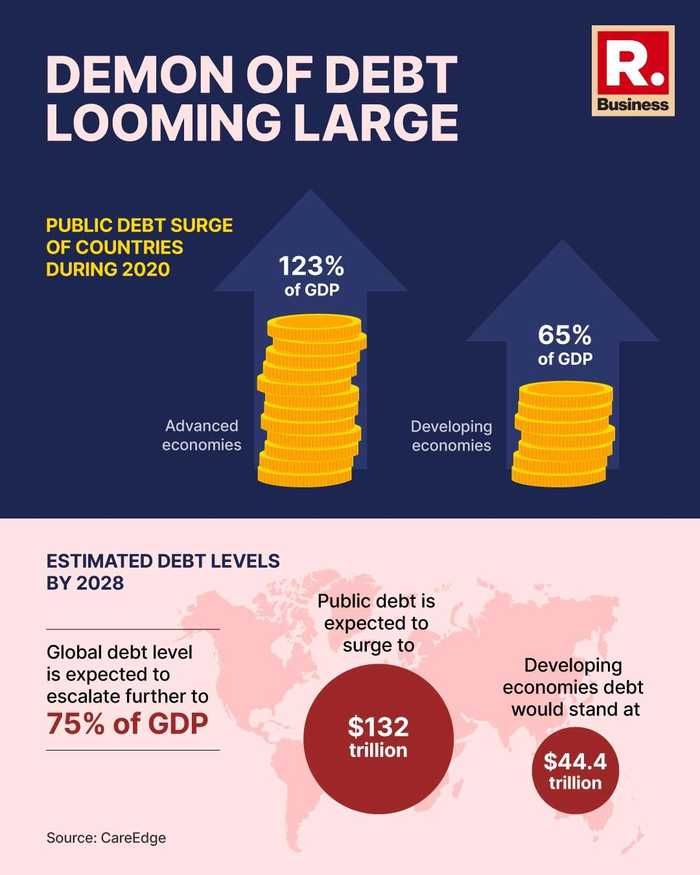Published 17:25 IST, December 22nd 2023
What would be the debt on emerging markets by 2028? All you need to know
By 2028, Global Public Debt is expected to surge to $132 trillion, of which EMDEs’ debt would stand at $44.4 trillion
- Economy News
- 4 min read
The surge in public debt has been a cause of concern for a long time now. In the post-pandemic era, the debt of various countries have surged massively. During the pandemic, in advanced economies, public debt surged to 123 per cent of GDP in 2020, while in emerging markets and developing economies (EMDEs), it reached 65 per cent of GDP, leading to widespread debt distress. According to a report by credit rating agency CareEdge, in EMDEs, the debt level has marginally increased to 64.2 per cent of GDP in 2022, mirroring the 2020 levels.
“The debt level is expected to escalate further to 75 per cent of GDP by 2028. Thus, by 2028, Global Public Debt is expected to surge to $132 trillion, of which EMDEs’ debt would stand at $44.4 trillion (China contributing USD 24.6 trillion, others contributing USD 19.8 trillion) about 33 per cent to the total,” report by CareEdge stated.
On the flip side, three years post-pandemic, the debt levels in advanced economies have moderated from the 2020 peaks to 112 per cent of GDP in 2022. According to the IMF’s World Economic Outlook October 2023 Database, the debt levels for advanced economies are projected to rise to 116 per cent of GDP by 2028.
According to the report, since 2020, about 19 economies have either defaulted on their debt obligations or restructured debt with 7 in 2022 alone. These numbers seem very high when compared to 11 sovereign defaults or debt restructuring events across countries between 2008-19. “According to the Bank of Canada-Bank of England database on sovereign defaults, the total sovereign debt in default amounted to $554 billion in 2022, about a 34 per cent jump as compared to 2021. Total sovereign debt in default as a per cent of World GDP was 0.6 per cent in 2022, the highest since 2014.,” the report mentioned.

In a bid to tame soaring inflation, the central banks across the world have raised the interest rates. The hike in interest rate has also posed a formidable challenge for the government in servicing their debts and servicing their interest payments.
“For heavily indebted advanced economies like the UK, USA, Italy, France, and Spain, interest payments on public debt as a percentage of GDP have been increasing,” Rajni Sinha, Chief Economist at CarEdge said. According to her, higher interest payments constrain fiscal capacity for other essential expenditures, such as health and education. For instance, the UK's interest payments reached $138 billion in 2022, significantly higher than initial government forecasts, primarily driven by high inflation. Additionally, the cost of new borrowings has risen, evidenced by widening yields.
Low-income EMDEs with substantial public debt, such as Sri Lanka, Ghana, Zambia, and Pakistan, are particularly affected by the increasing interest rate burden.
One interesting pattern in the post-pandemic world is seen in the composition of bilateral lenders from OECD countries to the rise of other official creditors like China. As per the report that will also have a bearing on the overall debt and sovereign debt repaying capability in the current cycle. “Change in the Composition of Bilateral Lenders Over the past decade, bilateral loans from China, India, and the Gulf States have seen a considerable increase,” the report mentioned. According to the report, China's lending activities have garnered significant attention.
Data from the World Bank indicates that loans from China escalated from $333 billion in 2012 to $952 billion in 2022, marking a CAGR of 11 per cent. “Predominantly, these loans were extended to low-income developing economies, oil-exporting nations like Ghana, countries involved in the Belt and Road Initiative (BRI) such as Sri Lanka and Pakistan, as well as small economies in close geographical proximity to China, like Laos and Cambodia, and some smaller European economies,” CareEdge said.
Updated 17:25 IST, December 22nd 2023